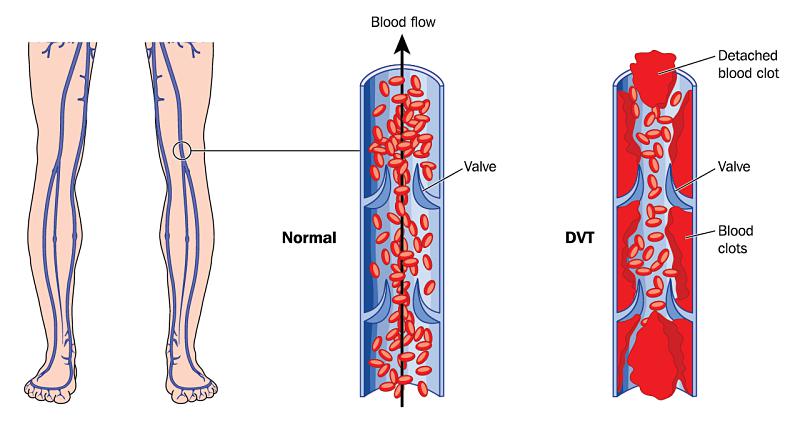What Is DVT and Why Is It a Concern?
Deep Vein Thrombosis (DVT) is a health condition that happens when a blood clot forms in one of the body’s deep veins, typically in the lower limb. While DVT can occur anywhere, the legs are the most common site, mainly due to slower blood flow in the lower extremities. The real danger behind DVT is that many people may not even realize they have it, as symptoms can be mild or go unnoticed. However, if a clot breaks loose, it can travel through the bloodstream and block blood flow to the lungs, leading to a life-threatening complication known as a pulmonary embolism.
The risk of DVT increases during long periods of inactivity, such as long-haul flights, bus rides, or car journeys. In such conditions, the legs remain motionless, making blood pooling and forming clots easier. That’s why healthcare professionals encourage people, persistent travelers, to manage their risk actively. Among the most effective non-invasive strategies is pressure stockings for DVT, which can help maintain healthy blood flow during prolonged immobility by providing gentle, graduated compression to the lower legs.
Common Risk Factors Associated With Travel
DVT risk during travel is influenced by several factors, including immobility, confined seating, personal or family history of clots, obesity, recent surgeries, pregnancy, childbirth, chronic illnesses, and hormonal medications. Immobility creates an ideal environment for blood to pool in veins, forming a clot. Constrained seating, particularly middle seats on airplanes, further increases the risk. Individuals with underlying health concerns, particularly those with a history of clots, obesity, recent surgeries, pregnancy, childbirth, and chronic illnesses, are also at higher risk. Flights over four hours and journeys with limited movement are particularly problematic.
Recognizing the Signs of DVT
The subtlety of DVT symptoms makes the condition even more dangerous. Some people notice no warning signs at all until a complication develops. When symptoms are present, they often include swelling, usually in one leg, that doesn’t resolve. Pain or tenderness may develop in the affected area, sometimes starting in the calf and feeling like cramping or soreness rather than sharp pain. The skin may also feel warm to the touch, and a change in color, such as redness or bluish tint, may appear.
Detecting DVT early is crucial but can be challenging, especially when traveling. Suppose any new, unusual leg pain or swelling occurs during or after a long trip. In that case, taking it seriously is critical—prompt evaluation and treatment can prevent a minor problem from becoming a potentially fatal pulmonary embolism.
Simple Lifestyle Changes for Prevention
Preventing DVT is often about small, consistent decisions that build up to significant benefits. Hydration plays a big role, as dehydration can cause blood to become more viscous, raising clot risk. It’s a good practice to drink water regularly on flights and limit consumption of alcohol and caffeinated beverages, both of which can promote fluid loss.
Movement is another cornerstone of prevention. Simple stretches, ankle circles, or getting up and walking every hour or two can help keep blood flowing. If standing up isn’t possible—such as during turbulence on a plane or a long bus ride—flexing the feet and legs in your seat can offer a reasonable substitute. Wearing loose clothing and choosing aisle seats make it easier to stay mobile and reduce restrictions around the legs, making preventive movement more practical.
The Role of Compression Socks
Compression socks provide a biomechanical solution to a physiological problem. By applying gentle, graduated pressure, these stockings squeeze the legs just enough to support vein function, pushing the blood upward and reducing pooling in the lower extremities. Multiple studies support compression as a key method for lowering DVT risk while traveling, with many experts agreeing they are an essential part of a prevention toolkit for at-risk individuals.
Choosing the right compression socks involves more than picking a size. The pressure rating, measured in millimeters of mercury (mmHg), should suit your needs and comfort. Some travelers wear them for personal comfort, even on shorter trips, reporting less fatigue or swelling at their destination.
Evidence-Based Prevention Strategies
DVT prevention relies on a three-pronged approach: hydration, mobility, and mechanical compression. Regular movement and hydration reduce risk for healthy travelers, while medical-grade compression therapy is recommended for risk factors. These strategies remain the gold standard, and healthcare providers may prescribe blood thinners or additional therapies in high-risk cases. Simple, practical interventions are effective for many travelers.
When to Seek Medical Advice?
Risk factors aren’t evenly distributed; some travelers need additional protection. If you have a history of DVT, recent major surgery, active cancer, or take medications known to increase clot risk, a pre-travel consultation is wise. Physicians can tailor recommendations, including temporary use of prescription blood thinners, custom compression wear, or other measures.
If unusual swelling, redness, or pain in the leg emerges after a long journey, seek medical attention immediately. Rapid diagnosis and intervention can prevent escalation to pulmonary embolism, which is significantly more dangerous and harder to treat.










